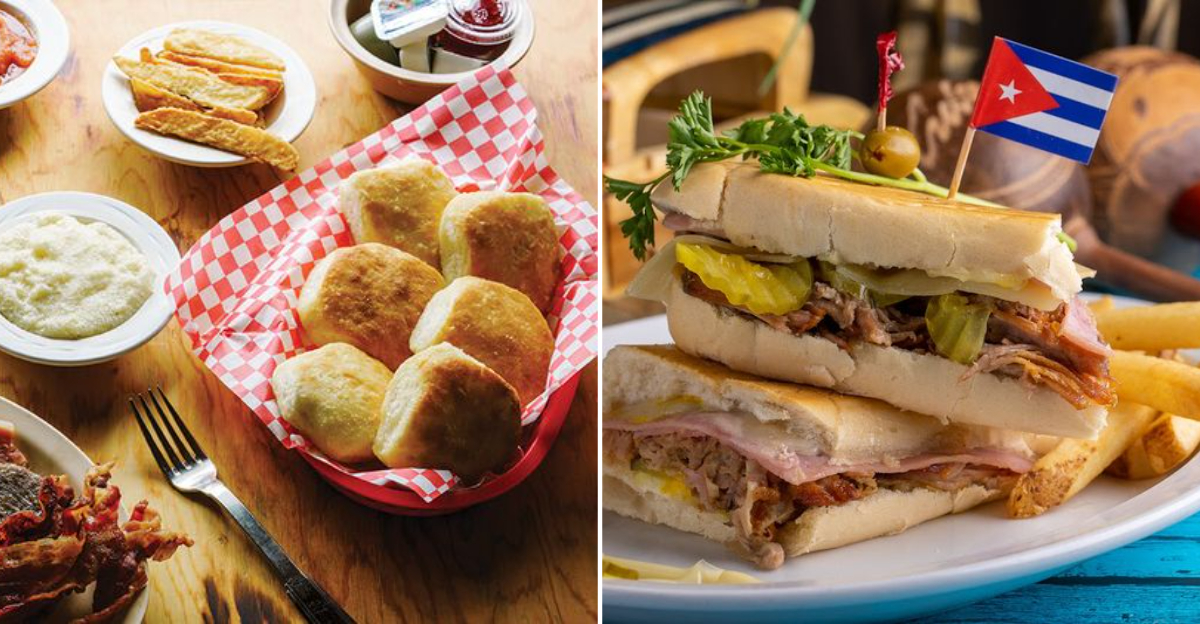11 North Carolina Restaurants Still Using Family Recipes From Generations Ago

There’s something magical about a meal made from a recipe that’s been passed down through generations.
Here in North Carolina, several restaurants honor their heritage by continuing to serve dishes exactly as grandma or great-grandpa made them.
I’ve spent years exploring these culinary treasures across our state, and each bite tells a story of family pride, tradition, and flavors that have stood the test of time.
1. Dick’s Hotdog Stand: Wilson’s Century-Old Wiener Wizardry
Last summer, I stood in line at Dick’s just like my grandpa did in the 1940s. The same Greek chili recipe that Socrates Gliarmis created in 1921 still sizzles on their grill today, making their dogs legendary throughout eastern NC.
The family’s secret? They’ve never written down the exact measurements! Each generation learns by doing, standing shoulder to shoulder with their elders until the technique becomes second nature. Their chili has that perfect meat-to-spice ratio that tingles your taste buds without overwhelming them.
What really tickles me is how they still serve their dogs the old-school way – on steamed buns with that snap when you bite in. Three generations later, Dick’s remains a testament to the power of keeping it simple and authentic.
2. Lexington Barbecue: Smoke Signals From 1962
Holy smoked pork, Batman! The first time I tasted Wayne Monk’s legendary barbecue, I nearly fell off my chair. Since opening in 1962, this joint (affectionately dubbed ‘The Honeymonk’ by locals) has been smoking pork shoulders over hickory coals using the same technique Wayne learned as a teenager.
Their distinctive red slaw—don’t you dare call it coleslaw—gets its tangy kick from the same vinegar-based recipe the Monk family has used for 60+ years. The pitmasters still hand-chop every piece of meat, rejecting modern shortcuts that would compromise their craft.
What makes me chuckle is how they measure cooking time not by clocks but by the color of the meat and the feel of the bone—a skill passed from pitmaster to apprentice that no recipe book could ever capture.
3. Red Bridges Bar-B-Q: Shelby’s Slow-Cooked Family Legacy
Would you believe I once drove three hours just for a sandwich? The Bridges family has been pit-cooking pork the exact same way since 1946, when Red and Lyttle Bridges first opened their doors. Their granddaughter Natalie now carries the pitmaster torch, ensuring those hickory embers keep glowing.
The sauce recipe—a closely guarded family secret—remains unchanged since Lyttle first mixed it up in her kitchen. What floors me is how they still cook their meat for a full 10 hours over hickory wood, refusing to cut corners even when wood prices skyrocket.
My favorite part? The red slaw (they call it ‘Red’s slaw’) still follows Lyttle’s original recipe, with that perfect balance of tangy and sweet that complements the smoky meat like they were made for each other. Because, well, they were!
4. Bum’s Restaurant: Ayden’s Wood-Fired Wonder
I nearly wept tears of joy the first time I tried Bum’s collard greens. The Dennis family has been serving authentic Eastern North Carolina barbecue since 1963, but what really sets them apart is how they grow many of their vegetables on their own family farm!
Latham “Bum” Dennis learned his craft from his father, who ran the legendary Skylight Inn. The whole-hog cooking method they use dates back to the 1830s, when their ancestors first started cooking pigs for community gatherings. Those same techniques—cooking over oak wood coals in brick pits—continue today.
The cornbread recipe came from Bum’s grandmother, who made it in cast iron pans over an open hearth. When you taste it alongside their yellow rutabaga stew (a Dennis family specialty for generations), you’re literally consuming history with every delicious forkful.
5. Sunrise Biscuit Kitchen: Flour-Dusted Family Tradition
Picture this: I’m sitting in my car at 7 AM, biting into a cathead biscuit so flaky it should be illegal. Founder David Allen’s grandmother taught him to make biscuits when he was just a boy, and that same recipe has been satisfying hungry North Carolinians since 1978.
The current owner, Carolyn Dunston (Allen’s sister), still uses the original family technique—cutting cold butter into flour by hand and folding the dough just enough to create those heavenly layers. No fancy machines, no pre-mixed ingredients, just generations of know-how in every bite.
What cracks me up is how protective they are of the recipe—employees must sign confidentiality agreements before learning the sacred biscuit method! When you taste the difference between their hand-crafted masterpieces and mass-produced imposters, you’ll understand why this family guards their grandmother’s legacy with such delicious devotion.
6. Nellie’s Southern Kitchen: Jonas Family’s Belmont Treasure
No joke—I bumped into a Jonas Brother while scarfing down chicken and dumplings here! Opened by the Jonas family (yes, THOSE Jonases) in 2016, this restaurant celebrates their grandmother Nellie Jonas’s cherished recipes from the 1760s.
The chicken and dumpling recipe remains exactly as Nellie made it—hand-rolled dumplings in a broth that simmers for hours. Kevin Jonas Sr. grew up eating these comfort foods and wanted to share his grandmother’s culinary legacy with the world. The sweet potato casserole still follows Nellie’s handwritten recipe card, complete with her secret brown sugar pecan topping.
My absolute favorite thing about Nellie’s is how they’ve preserved not just the recipes but the feeling of Sunday dinner at grandma’s house. When the staff tells you to “come back when you’re hungry,” they mean it with the same warmth that Nellie herself would have expressed.
7. C. Winkler Bakery: Old Salem’s 200-Year-Old Moravian Magic
Pinch me—am I in 2023 or 1807? Walking into C. Winkler Bakery in Old Salem feels like time travel. Bakers in period clothing still create Moravian cookies and sugar cake using the original recipes brought by German-speaking immigrants over two centuries ago.
The dome-shaped brick oven, built in 1800, continues to bake these treats exactly as it did when Christian Winkler first fired it up. Their paper-thin Moravian cookies follow the spice proportions recorded in handwritten family cookbooks from the early 19th century. The ingredients may be measured in modern units now, but the ratios remain sacred.
What makes me giggle is watching tourists’ faces when they realize the “costume” bakers are actually making everything from scratch using historical methods. The lovefeast buns—a Moravian tradition—still feature the distinctive blend of potato flour and mace that made them famous generations ago.
8. Mama Dip’s Legacy At Tonya’s Cafe: Chapel Hill Soul Food Royalty
I’ve never met a sweeter potato pie than the one at Tonya’s Cafe! When legendary restaurateur Mildred “Mama Dip” Council passed away in 2018, her daughter Tonya Council ensured her mother’s soul food legacy would live on through this cozy spot.
The famous chicken and dumplings recipe dates back to the early 1900s, when Mama Dip learned it from her grandmother who had been born into slavery. Tonya still makes the cornbread using her great-grandmother’s cast iron skillet—the seasoning built up over a century adds a flavor no new pan could replicate.
What warms my heart is how Tonya has preserved her mother’s cooking philosophy: “measure with your heart.” While she’s added her own famous pecan cookies to the menu, the core recipes remain untouched tributes to Mama Dip’s culinary genius that put Chapel Hill soul food on the national map.
9. Lucky 32 Southern Kitchen: Grandmothers’ Greatest Hits
Confession time: I once tried to bribe a server for their voodoo sauce recipe. Chef Jay Pierce collects and preserves family recipes from grandmothers across North Carolina, turning Lucky 32 into a living museum of Southern culinary heritage.
Their signature collard greens come from Miss Eloise McCain’s 1940s recipe, complete with the pot likker that Southern grandmas know is liquid gold. The skillet-fried chicken follows a technique that Chef Jay learned from his own grandmother, who insisted on a 24-hour buttermilk soak—no shortcuts allowed!
My favorite quirk is how they credit each recipe’s original creator on the menu. When you order “Miss Lucy’s Mac and Cheese,” you’re not just getting comfort food—you’re tasting the exact dish that has starred at family reunions since the Great Depression. The restaurant even hosts “Grandmothers’ Night” where local grandmas judge new dishes for authenticity!
10. Biscuitville Fresh Southern: The Biscuit That Built A Legacy
Y’all won’t believe this, but I once drove 45 minutes before sunrise just to get Biscuitville’s breakfast! The Jennings family has been using the same biscuit recipe since Maurice Jennings started making them in 1966. Every single biscuit is still made from scratch every 15 minutes—I’ve watched the bakers through their famous “biscuit theater” windows!
The recipe came from Maurice’s mother, who taught him that proper biscuits require real buttermilk and a gentle touch. Current CEO Burney Jennings (Maurice’s son) still requires every store manager to master the original technique before taking charge of a location.
What tickles me pink is their “Biscuit School”—a required training program where employees learn to make the family biscuits exactly as Grandma Jennings did. They even measure success by the “three-finger test”—a perfect Biscuitville biscuit should rise to exactly three fingers high!
11. Havana Carolina: Cuban Family Secrets In Concord
Last month, I practically licked my plate clean at this Cuban gem! The Rodriguez family fled Cuba in the 1960s, bringing nothing but the clothes on their backs and their treasured family recipes memorized by heart.
Their ropa vieja follows the exact preparation that Abuela Rodriguez used in her Havana kitchen in the 1930s. The black beans still simmer for hours with the special blend of spices that have been passed down through four generations of Rodriguez women. Even their mojitos use a mint-muddling technique that great-grandfather Rodriguez developed while working as a bartender in pre-revolutionary Havana.
My favorite part? The flan recipe survived because Grandmother Rodriguez taught it to her daughters through song! The melody’s rhythm helped them remember the exact timing for caramelizing sugar. When you hear soft singing from the kitchen, you know someone’s making flan exactly as it was made in Cuba nearly a century ago.
